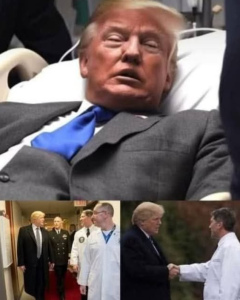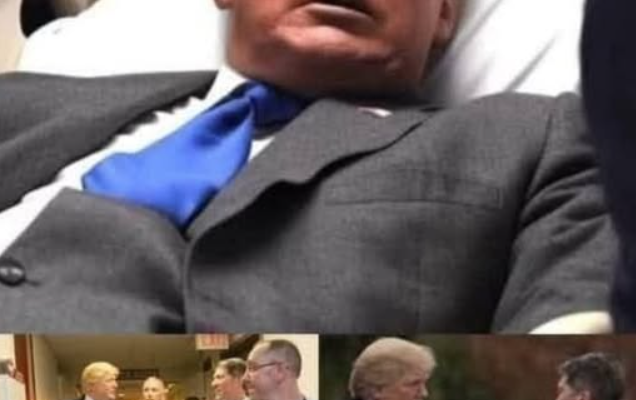In the early hours of a tense morning in Washington, D.C., rumors began to spread rapidly across social media platforms claiming that former U.S. President Donald Trump had been shot again. Within minutes, posts began circulating with bold headlines designed to shock and stir public emotion. The wording was dramatic and alarming, using phrases like “Minutes Ago,” “Shock in D.C.,” and “Trump Shot Again.” Many people immediately shared the claims, but what followed was a wave of confusion as official news sources remained silent.
As the claims spread, people turned to credible news outlets to verify whether any such incident had occurred. In genuine emergencies, information is typically released within minutes by major outlets, but in this case, none of the respected networks or wire services reported any new attack. No alert came from the Secret Service, no statement from law enforcement, and no official confirmation from Trump’s team. This silence began to speak volumes, suggesting that the claim was likely false or grossly exaggerated.
The story closely resembled a verified incident from July 2024, when Trump was wounded during a campaign rally in Butler, Pennsylvania. On that day, a lone gunman opened fire from a nearby rooftop. The bullet grazed Trump’s ear, leaving him bloodied but alive. The incident shocked the world, led to intense security investigations, and forever changed the tone of the election season. Because of how widely that moment was broadcast, any similar claim today instantly triggers public anxiety. But this time, there was no live footage, no on-the-ground reporting, and no press briefing—only rumors.
As online claims continued, some versions of the story began to shift. One post asserted that Trump had been hit by flying glass rather than a bullet. Another suggested that the incident happened “outside the White House,” without providing names, dates, or any photographs. The lack of consistency in the details was an early warning sign of misinformation at work. When real events occur, details tend to align quickly, with multiple agencies and journalists confirming facts. In contrast, rumors often morph and contradict themselves as they spread.
Disinformation campaigns thrive in moments like this. People share emotional headlines without reading full stories, and before long, millions can believe something that never happened. Experts have long warned about how misleading posts on social media can influence public perception and cause unnecessary panic. In this case, the wording of the claim—“Minutes Ago” and “Shock in D.C.”—was deliberately chosen to suggest urgency. By the time fact-checkers step in, the rumor has often traveled too far.
Reliable sources remained firm throughout the day. Major newspapers and television networks published updates clarifying that no attack on Trump had occurred that morning. Security officials confirmed there was no active incident at any federal building related to Trump. Even spokespeople close to Trump’s team did not release any emergency statement, which would have been expected if something serious had happened. The absence of evidence quickly became clear evidence of absence.
It is also worth understanding why Trump remains a frequent target of false claims. As a polarizing figure, stories involving him tend to gain massive traction online. For those who wish to spread misinformation or generate clicks, attaching Trump’s name to a dramatic headline almost guarantees attention. In the past, many similar false alarms have circulated—claims of arrests, medical emergencies, or assassination attempts that turned out to be fabricated or distorted.
The memory of the 2024 rally shooting plays a powerful role in why these rumors spread so quickly. That incident was real, frightening, and seared into public memory through images of Secret Service agents rushing Trump offstage as blood ran down his face. For millions, that image remains vivid. When a new claim emerges with even a hint of similarity, people react emotionally before seeking facts. Misinformation spreads best in environments where people are already primed to believe something is possible.
In Washington itself, the day remained calm. Tourists moved around the National Mall. Security presence was normal, and there were no signs of an emergency response. Reporters stationed outside government buildings described a quiet morning with no unusual activity. If a major incident involving a former president had actually happened, law enforcement would have flooded the area, and live news coverage would have been everywhere. The lack of such visible signals confirmed that the claim was baseless.
By midday, multiple fact-checking organizations issued statements labeling the story a hoax. They traced several of the viral posts to unverified Facebook pages and low-credibility websites known for spreading sensationalized content. Some of these pages have a history of altering old footage or inventing stories to drive engagement. The structure of the false story was familiar: a shocking headline, no verifiable source, a vague location, and shifting details.
Meanwhile, the public reaction reflected the polarized climate in the country. Supporters and opponents of Trump began arguing online about what had supposedly happened, even though nothing had. This is one of the dangers of misinformation—it can create real tension and conflict over imaginary events. In the modern media landscape, a single fake headline can shape discussions and emotions for hours, even days, before the truth catches up.
Ultimately, the claim that Trump was “shot again” turned out to be false. No shooting occurred, no hospital visits took place, and no security alerts were issued. Trump was safe, and Washington remained peaceful. What did happen was a large-scale test of how fast misinformation can spread and how important credible reporting remains.
This episode highlights the need for caution and critical thinking. In moments of panic, it is natural to want to share breaking news quickly. But doing so without verification fuels confusion. By pausing to check official statements or trusted outlets, individuals can play a small but crucial role in slowing the spread of false stories. The lesson is simple: the louder the claim, the more carefully it should be checked.
In the end, the false alarm faded from the headlines as quickly as it had appeared. But it served as another reminder of the power of words online. Sensational phrases can cause real-world fear even when nothing has happened. It is a modern reality that truth must now compete with speed and sensation. And as this case showed, a lie can spread across the world in seconds, but the truth takes a little longer to catch up


